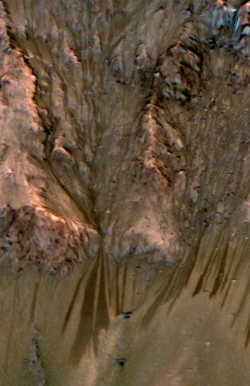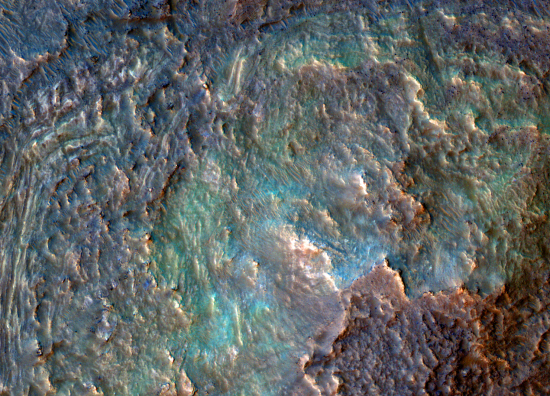The north pole of Mars in summer
The north pole of Mars in summer: the dry ice is gone, leaving an icecap of water only.
The north pole of Mars in summer: the dry ice is gone, leaving an icecap of water only.
The north pole of Mars in summer: the dry ice is gone, leaving an icecap of water only.

More evidence that there are active flows of water on Mars.
Dark, finger-like features appear and extend down some Martian slopes during late spring through summer, fade in winter, and return during the next spring. Repeated observations have tracked the seasonal changes in these recurring features on several steep slopes in the middle latitudes of Mars’ southern hemisphere.
Though there are a number of unsolved issues about these features, the best explanation appears to be a liquid brine.
Saltiness lowers the freezing temperature of water. Sites with active flows get warm enough, even in the shallow subsurface, to sustain liquid water that is about as salty as Earth’s oceans, while pure water would freeze at the observed temperatures.
Go here to see the full image.
Cost issues might force Europe to downsize its 2016 Mars mission.
Mars Reconnaissance Orbiter released this picture yesterday of what the Orbiter’s scientists have labeled “The crazy floor of Hellas Basin.” Below you can see a cropped image of only one part of the large higher resolution image. The NASA caption says that the wild colors probably “indicate that diverse minerals are present,” meaning that any settlers of the red planet will probably take a close look at this location with the reasonable hope of finding the resources they need to colonize a planet.
To me, these colors also indicate that this place on Mars would probably one of its most popular tourist spots. As I look at the image my eye instinctively wants to trace out the best trail route along the ridges and down into the gullies in order to give hikers the best view of this colorful terrain.

After almost three years and seven miles of travel, Opportunity is now only about 1500 feet from the rim of Endeavour Crater.
Opportunity has cut the distance to Endeavour Crater to only 3,600 feet.
The next Mars rover will land at Gale Crater.
The car-sized Mars Science Laboratory, or Curiosity, is scheduled to launch late this year and land in August 2012. The target crater spans 96 miles (154 kilometers) in diameter and holds a mountain rising higher from the crater floor than Mount Rainier rises above Seattle. Gale is about the combined area of Connecticut and Rhode Island. Layering in the mound suggests it is the surviving remnant of an extensive sequence of deposits. The crater is named for Australian astronomer Walter F. Gale. . . . The portion of the crater where Curiosity will land has an alluvial fan likely formed by water-carried sediments. The layers at the base of the mountain contain clays and sulfates, both known to form in water.
More here, including images of landing site.
On July 17 the Mars rover Opportunity passed the twenty mile mark on its now seven year journey on Mars. The image below was taken on that day. In the distance, now only about 4,000 feet away, can be seen the rim of Endeavour Crater, fourteen miles wide. Opportunity has been traveling toward that crater now since 2008.
With the rover able to travel about 300 to 500 feet each sol, it should be reaching the crater’s rim sometime in the next few weeks.

NASA to announce on Friday the landing site of Curiousity, the next Mars rover.
Gale Crater now heads the list for Curiosity’s landing site on Mars.
Better buy that ticket now if you want to see the last shuttle launch from the best spot: Online prices have soared for space shuttle Atlantis launch tickets.
Tear-drop shaped mesas on Mars suggest ancient oceans to scientists.
Magnetic bubbles at the edge of the solar system.
Opportunity’s target on the rim of Endeavour crater has been dubbed “Spirit Point” by the science team in honor of the now defunct rover.
The Russian/ESA Mars 500 mission has completed a year of its 520-day simulated flight to Mars.
The crew, who spent 250 days working on maintenance and scientific experiments before a 30-day stint performing tasks on a simulated Martian surface, are currently on their “return trip” to Earth.
This simulated all-male flight is going better than the last:
In 1999, an experiment in the same Moscow warehouse fell to pieces after a Russian team captain forced a kiss on a Canadian woman, and two Russian crewmembers had a bloody fistfight.
Opportunity’s travels on Mars have now exceeded 30 kilometers.
Opportunity’s journey across the deserts of Mars continues; with pictures.
A bullet dodged? The next Mars rover, the Mars Science Lab, appears to be okay after last week’s mishap.
NASA has decided to abandon efforts to contact the rover Spirit, incommunicado for more than a year.
Facing a launch window that ends December 18, the next rover mission to Mars was damaged last week upon arriving at the Kennedy Space Center.
Deep fractures on Mars, some more than 1500 feet deep.
I believe him when he says he’ll launch his first manned mission in three years. However, I think he seriously underestimates the challenges of a mission to Mars, based on our present engineering abilities to build interplanetary spaceships.
Scientists find a gigantic and previously unknown deposit of CO2 at Mars’ south pole.
“We already knew there is a small perennial cap of carbon-dioxide ice on top of the water ice there, but this buried deposit has about 30 times more dry ice than previously estimated,” said Roger Phillips of Southwest Research Institute in Boulder, Colo. Phillips is deputy team leader for the Mars Reconnaissance Orbiter’s Shallow Radar instrument and lead author of the report. . . . “When you include this buried deposit, Martian carbon dioxide right now is roughly half frozen and half in the atmosphere, but at other times it can be nearly all frozen or nearly all in the atmosphere,” Phillips said.
What this discovery means is that, depending on Mars’ orbital circumstances, its atmosphere can sometimes be dense enough for liquid water to flow on its surface.
Sounds crazy, but it’s true: The budget chaos at NASA has caused the ESA to halt work on its own Mars orbiter and rover.
Picking the landing spot for the next Mars rover: down to four finalists.